Huygens discovered the first known satellite, Titan, of the planet Saturn in 1655. Herschel later discovered two more satellites, Mimas and Enceladus, while Cassini discovered four others: Tephia, Dione, Rhea, and Japet. Ground-based observations in the 19th century led to the discovery of Hyperion and Theba. From 1979 to 1981, eight more satellites were discovered: Atlas, Prometheus, Pandora, Elena, Janus, Epimetheus, Calypso, and Telesto. In 1990, the satellite Pan was also discovered. Janus, the closest satellite to Saturn, was only detected during an eclipse of the planet’s rings, creating a bright halo in the telescope’s view. Titan, the largest satellite of Saturn, is one of the largest satellites in the entire solar system in terms of size and mass. It has a diameter similar to that of Ganymede and is surrounded by an atmosphere with moving opaque clouds. Titan is even larger than the planet Mercury. Astronomers believe it is composed of equal amounts of rock and water ice. However, the most notable feature of Titan is its thick atmosphere, primarily made up of nitrogen with some methane, which is a natural gas on Earth. No other moon in our solar system has such an atmosphere. The atmospheric pressure on Titan is not significantly higher than on Earth, but the temperature is a frigid -180°C. At this temperature, methane can exist as a gas, liquid, or solid, depending on local conditions. This makes Titan somewhat similar to Earth, as it can experience rain, snow, oceans, and rivers, but all composed of methane instead of water. All of Saturn’s satellites, except for Phebe, have a straight-line orbit, while Phebe has a large eccentric orbit in the opposite direction.
Back in 2000, a dozen satellites were discovered and were given the designations S/2000 S1 through S12. The specifics of their orbits are still being determined.
The system of satellites orbiting Uranus consists of a total of 27 satellites, with 20 of them having official names. Additionally, there is one satellite, S/1986 U10, which was discovered in 1999 using images captured by Voyager back in 1986, and another satellite, S/2001 U1, which was discovered in 2001.
The Uranus satellite system is comprised of 15 regular satellites that travel in nearly circular orbits in the plane of Uranus’ equator. Additionally, there are 5 distant irregular satellites that were discovered in 1997 and 1999. These irregular satellites have large inclinations and eccentricities in their orbits. The ground-based observations by Lassell, Herschel, and Kuiper led to the discovery of the five large satellites: Ariel, Umbriel, Titania, Oberon, and Miranda. These satellites have orbits that are almost aligned with each other. Out of all the satellites, Miranda is the most remarkable, with a diameter of about 500 km. Its surface is characterized by a variety of valleys, gorges, and steep cliffs. It appears that Miranda is formed by the fusion of three or four large stone fragments. It is possible that these fragments are remnants of a former moon that collided with an asteroid and has now reassembled its debris.
During Voyager’s flyby in 1986, a total of nine satellites were found. These satellites were given names inspired by characters from Shakespeare’s plays. The names of these satellites are Cordelia, Aphelia, Bianca, Cressida, Desdemona, Juliet, Portia, Rosalind, and Belinda. Additionally, the fifteenth satellite of Puck was discovered by Sinnott in 1985. Later in 1997, two more irregular satellites of Uranus named Caliban and Sycorax were also discovered. In 1999, three additional distant satellites were found and were named Prospero, Setebos, and Stephano, after characters from Shakespeare’s play The Tempest. Interestingly, in 1999, images captured by Voyager 2 from 13 years prior revealed another satellite orbiting Belinda, which was tentatively labeled S/1986 U10. Finally, in 2001, another far-off satellite of Uranus known as S/2001 U1 was discovered.
Uranus’s system displays a unique feature – its plane deviates significantly from the average plane of other planetary orbits. Along with its moons, Uranus also has numerous small particles that form rings, although these rings are quite different from the well-known rings of Saturn.
The Nereid satellite is a very small satellite with a highly elongated orbit. The distance between the satellite and the planet varies from 1.5 to 9.6 million kilometers. The satellite’s orbital motion is in a direct direction. In the years 2002-03, five distant satellites of Neptune were discovered and given the names S/2002 N1-N4 and S/2003 N1.
In 1978, a satellite was discovered orbiting the planet Pluto. This discovery is significant for two reasons. Firstly, it allows for a more accurate calculation of the planet’s mass based on the satellite’s orbit period. Secondly, it raises the question of whether Pluto itself is a “lost” satellite of Neptune.
The origin of these observed satellite systems is a crucial and complex question in modern cosmogony.
Understanding the origin of natural planetary satellites
Currently, there have been 136 planets’ satellites discovered. During the time of O.J. Schmidt, the number of known satellites was three times smaller. In his 1957 Four Lectures on the Theory of the Origin of the Earth, Schmidt put forth a general concept regarding the origin of satellites.
During the formation of planets, as particles approach large planet embryos, some of them collide with enough force to be ejected from the main group and begin to orbit the planet. This results in the formation of a dense cluster of particles orbiting the planetary embryo on elliptical paths. These particles also interact and change their orbits. On a smaller scale, similar processes occur within these clusters as in the formation of planets. Most of the particles will eventually fall onto the planet and become part of it, while some will form smaller clusters and become independent embryos – the future moons of the planets… As the orbits of the particles within a moon-forming cluster average out, the moon itself acquires a symmetric, almost circular orbit that lies in the same plane as the planet’s equator.
The concept of Moon formation based on this idea was later referred to as the coaccretion model (in Western literature, “accretion” encompasses both the attachment of a gaseous medium and the union of solid bodies, while in Russian literature, “accretion” typically refers to the attachment of a gaseous medium, and “accretion” refers to the union of solid bodies). This model can be applied to planets similar to Earth, but it does not encompass all types of satellite formation. For instance, in giant planets during the gas accretion stage, accretionary gas-dust disks are formed instead of near-planetary swarms. In the asteroid belt, where accumulation processes have been replaced by destructive collisions, satellite formation is only possible through the fragmentation of larger parent bodies. Lastly, for the Earth-Moon system, an alternative to coaccretion known as catastrophic origin has been considered in the past two decades. We will now briefly outline these different types using the Moon, the Galilean satellites of Jupiter, and the asteroid pair Ida-Dactyl as examples.
New information regarding the satellites orbiting the primary planets
In the Neptune system, the largest moon, Triton, which is located close to the planet, orbits in a circular path in the opposite direction of the planet’s rotation. This unique motion is not observed in any other moon in the solar system, as all other large moons have a direct motion. Up until recently, only one distant irregular moon, Nereid, was known to exist. Nereid follows a highly elongated orbit with an eccentricity of 0.75 and an average distance of 5 million kilometers from Neptune. Astronomers had predicted that there would be a significant group of small moons with backward motion in orbits outside of Triton, with a major semi-axis greater than 0.5 million km [3]. Nereid may be the largest member of this small group of moons with direct motion. However, the family of backward-moving moons should be even more significant. Many astronomers have made efforts to discover Neptune’s distant moons, and in 2002, a team of astronomers at the Harvard-Smithsonian Center for Astrophysics successfully found four of Neptune’s outer moons using the 4-meter telescope in Chile. Another moon was discovered in 2003. These moons are located much farther away from Neptune than Nereid, at distances ranging from 16 to 50 million kilometers. All of the moons have highly elongated orbits with eccentricities ranging from 0.2 to 0.6. Two of the moons, S/2002 N2 and N3, are 30 km in size and have a forward motion, while the other three moons, S/2002 N1 (50 km), S/2002 N4 (60 km), and S/2003 N1 (35 km), have a reverse motion. The orbital periods of these moons range from 7 to 25 years, whereas Nereid orbits Neptune in 1 year.
Pluto is accompanied by a unique companion known as Charon, which has a radius that is half the size of Pluto itself. Pluto has a radius of 1200 km, while Charon has a radius of 600 km. Charon’s orbit is nearly circular, with a radius of approximately 20000 km, making this system a double system. In systems where rotation data is available, the satellites of planets rotate synchronously with their orbital motion. This means that the satellite’s period of rotation around its axis is equal to the period of rotation around the planet. As a result, the satellite always presents the same face towards the planet, similar to how the Moon always presents the same face towards the Earth. The satellite’s axis of rotation is always perpendicular to the plane of its orbit. However, there is one exception to this rule, which is the satellite Hyperion, whose rotation is chaotic. As for the outer satellites of distant planets, little is known about their rotation.
How many satellites does each planet in the solar system have and what are they called?
For instance, the planet Earth has one satellite, known as the Moon 😉
Earth-Moon, Mars-Deimos, Phobos, Jupiter-Metis, Adrastea, Amalthea, Teba, Io, Europa, Ganymede, Callisto, Leda, Himalia, Lysithea, Elara, Alanke, Karme, Pasiphae, Sinope. Saturn-Prometheus, Pandora, Epitheus, Janus, Mimas, Enceladus, Tefia, Telesto, Calypso, Diona, Elena, Rhea, Titan, Hyperion, Japet, Feba. Uranus-Cordelia, Ophelia, Bianca, Cressida, Desdemona, Juliet, Portia, Rosalind, Belinda, Peck, Miranda, Ariel, Umbriel, Titania, Oberon. Neptune-Nayada, Thallassa, Despina, Galatea, Larissa, Protheus, Triton. Pluto-Nereida, Charon. This information is from my ENCYCLOPEDIA. Please note that everything is capitalized; I’ve just been lazy.
Jupiter. The largest gas giant in the solar system. It has over a thousand satellites (Rings). The largest of these is Europa.
Earth’s natural satellite, the Moon, is accompanied in our solar system by two other moons of Mars, Phobos and Deimos. The gas giant Jupiter has a total of 79 known moons, including Io, Europa, Ganymede, and Callisto, as well as lesser-known moons such as Himalia, Amalthea, Elara, Tebe, Metis, Adrastea, Pasiphae, Sinope, Karme, Lysithea, Ananke, and Leda. Saturn, another gas giant, has its own set of moons including Pan, Atlas, Prometheus, Pandora, Epimetheus, Janus, Mimas, Enceladus, Tethys, Telesto, Calypso, Dione, Elena, Rhea, Titan, Hyperion, Iapetus, and Thebe. Uranus, the seventh planet from the Sun, has moons like Cordelia, Ophelia, Bianca, Cressida, Desdemona, Juliet, Portia, Rosalind, Belinda, 1986U10, Puck, Miranda, Ariel, Umbriel, Titania, Oberon, Caliban, and Sycorax. Neptune, the eighth and farthest planet from the Sun, has moons such as Naiad, Thalassa, Despina, Galatea, Larissa, Proteus, Triton, and Nereid. And lastly, there is Pluto and its largest moon, Charon.
Mars has two natural satellites, Phobos (named after the Greek god of fear) and Deimos (named after the Greek god of terror). These satellites have irregular shapes and lack an atmosphere. They both orbit Mars in elliptical paths. The surfaces of Phobos and Deimos are marked by numerous craters. On the other hand, Jupiter boasts a total of 16 satellites, including Adrastea, Metida, Amalthea, Thebes, Io, Lysithea, Elara, Ananke, Carme, Pasiphae, Sinope, Europa, Ganymede, Callisto, Leda, and Himalia. Meanwhile, our home planet Earth has a singular satellite, which we commonly refer to as the Moon. Lastly, Saturn possesses a rich collection of satellites, namely Pan, Atlas, Prometheus, Pandora, Epimetheus, Janus, Mimas, Enceladus, Tefia, Telesto, Calypso, Dione, Helena, Rhea, Titan, Hyperion, Japetus, Phebe, and Luna.
Interestingly, according to our school atlas, Jupiter is reported to have 62 satellites, while Saturn is said to have 63 satellites.
The planet Venus is located second in order from the Sun.
Venus, which is positioned as the second planet from the Sun, is approximately 108 million kilometers away from it. It orbits around the Sun for a period of 225 days, with an average speed of 35 km/s, and it takes 243 days to complete one axial rotation. Additionally, Venus rotates as the “morning star” in the opposite direction compared to most other planets. In terms of its characteristics, Venus has a mass that is 0.82 times that of Earth, and its volume, radius, and density are approximately similar.
Atmosphere
Observing the surface of the planet is impossible due to the density of its atmosphere and the thickness of its cloud cover, making it distinct from other planets like Mars. The composition of the atmosphere is relatively simple, consisting of 96% carbon dioxide and nearly 4% nitrogen, with trace amounts of argon, water, and sulfur dioxide. The planet’s surface experiences immense pressure, reaching up to 93 atmospheres, and its temperature of 467 °C surpasses that of Mercury, even though it is further from the Sun. This extraordinary heat is a result of the dense atmosphere creating a greenhouse effect.
One intriguing aspect is the lack of daily temperature fluctuations, which can be attributed to the thermal inertia of the atmosphere.
The topography of the planet
The topography is characterized by active tectonic activity. This can be observed through the presence of fossilized lava flows and newly formed stone screes. The two main continents on Venus, Ishtar and Aphrodite, are comparable in size to Europe and are home to numerous volcanoes. In fact, Venus is considered the most volcanically active celestial body in our solar system.
During volcanic eruptions, powerful electrical discharges are often observed.
The surface of the planet is diverse, with both flat areas and regions with height differences of 2-3 kilometers. There are also notable geological features such as a circular basin measuring 1500 kilometers in diameter and a plain spanning 800 kilometers. Additionally, meteorite craters ranging from 35 to 150 kilometers in diameter have been discovered.
Exploring the surface
As we depart from the rocket, we descend towards the surface of Venus. Thanks to the ingenious invention of the thermobarocapsule, we are able to avoid being flattened like a flounder at the bottom of the sea. We equip ourselves with goggles fitted with special filters and peer through the portholes.
Above us, lightning bolts streak through the expanse of space, creating a mesmerizing display of fiery branches. Meanwhile, sulfuric acid rains down upon us. On the horizon, two colossal volcanoes erupt simultaneously.
We continue to navigate through the clouds of smoke and fire. Suddenly, a mountainous valley unfolds before our eyes, scattered with fragments of stone and small brown pebbles. The landscape gradually brightens, as if the sun has emerged from behind the clouds. In the near distance, the silhouette of low mountains becomes visible.
Venus has a weak magnetic field, with the core (3000 km) composed of molten iron and nickel, and the mantle (3000 – 3300 km) consisting of silicon compounds. The planet’s crust, ranging from 16 to 50 kilometers in thickness, is comprised of silicon rocks that have a density comparable to that of Earth.
Several characteristics
Density and Volume of the Atmosphere
Approximately 90% of the atmosphere is concentrated within a height of 28 kilometers, and its mass is equivalent to one-third of the mass of the Earth’s oceans. While nitrogen is relatively scarce in the atmosphere, its absolute quantity is five times greater than that found within Earth’s atmosphere. The density of Venus’ atmosphere near its surface is fifty times that of Earth. The layer of clouds, spanning twenty kilometers, begins at an altitude of 50 kilometers and is primarily composed of sulfuric acid. Rain on this planet is highly unlikely to support life.
Satellites
It is only Venus and Mercury that have not obtained any satellites. Indeed, during the 27th and 28th centuries, numerous astronomers made attempts to locate satellites orbiting Venus and even appeared to discover some, but ultimately, these findings turned out to be incorrect. However, there exists an asteroid known as 2002 VE, which is regarded as a quasi-satellite. It has been accompanying another celestial body for 7000 years, but it will soon part ways with it.
The planet Venus is the most enigmatic planet in our solar system due to the lack of detailed examination. Here are a few of its perplexing mysteries:
- Planetary rotation: One puzzling question is why Venus rotates in the opposite direction compared to the other planets. It is believed that a celestial object collided with Venus in the past, causing this unusual rotation.
- Lightning: Despite the presence of sulfuric acid clouds on Venus, which should prevent lightning, the Venus Express mission has detected electrical storms. The evidence for these storms contradicts our understanding of their formation and characteristics, suggesting that there is more to learn about this phenomenon.
- Superrotation: The atmosphere of Venus moves 20 times faster than the planet’s rotation, creating a hurricane that defies explanation as to why it doesn’t affect the planet’s surface.
Discovery
The initial device to investigate the planet was called Venera-1. It was an automated station from the Soviet Union. It was launched on February 12, 1961. Following three months, it entered the orbit of the morning star. A couple of months later, the U.S. probe Mariner 2 approached the planet. However, it was only at the conclusion of 1970 that “Venus-7” was able to successfully land on the planet’s surface and function in the intense Venusian heat for a duration of 23 minutes.
“Venus 15 and 16, along with Magellan, conducted extensive mapping of the misty planet. They made remarkable discoveries in the plains of eastern Aphrodite. The Maxwell Mountains, towering 11 kilometers above the planetary average, were meticulously described. Extensive research has been conducted on the topography of 55 different regions of Venus, including the impressive 1.5 kilometer-high Mount Shapash. Interestingly, the districts on Venus are predominantly named after females, with some truly unique ones such as the Land of Lada, the Snow Maiden plain, and the Baba-Yaga plain.”
Admiration for Venus is inevitable. This remarkable planet resembles a bundle of emotions. The activities happening in its atmosphere and on its surface are as dynamic and vigorous as human sentiments. While humans express themselves through emotions, Venus does so through lightning and hurricanes. And both are equally guarded against prying eyes. Only the most determined and curious individuals will succeed in comprehending and unraveling the enigmas of the planet that carries the name of the revered goddess of love.
comments powered by HyperComments
which celestial bodies have natural satellites?
Out of the nine planets in our solar system, Mercury and Venus are the only ones that do not have any satellites orbiting around them. All the other planets, on the other hand, have their own satellites. For instance, Earth has just one satellite, which is none other than the Moon (and boy, is it massive!). As for Mars, it has a total of two satellites known as Phobos (meaning “fear” in Greek) and Deimos (meaning “terror” in Greek). These satellites were first discovered in the year 1877, and they could only be seen through powerful telescopes and photographed by space stations. In terms of their appearance, they are shapeless masses similar to asteroids, with their surfaces covered in craters.
When it comes to Jupiter, it has four satellites known as the Galilean satellites – Io, Europa, Ganymede, and Callisto. These satellites were actually discovered way back in 1610, and they can even be seen through a pair of binoculars. In fact, they are the largest satellites that orbit Jupiter. Ganymede and Callisto are even comparable in size to the planet Mercury. One interesting fact about the satellite known as Io is that it has several active volcanoes. In addition to these four, there are also twelve smaller satellites that have irregular shapes.
Saturn, on the other hand, takes the crown for having the most number of satellites among all the planets in our solar system. It has a total of 23 satellites, with the largest one being Titan, which is actually twice the size of our Moon. Meanwhile, the brightest satellite in the solar system is Enceladus, with its surface shining as bright as freshly fallen snow.
Uranus has 15 satellites, with the largest ones being Miranda, Ariel, Umbriel, Titania, and Oberon. As for Neptune, it has two large satellites that can be observed through a telescope – Triton and Nereida. The other four satellites of Neptune are still not well-understood. Finally, the smallest planet in our solar system, Pluto, has a single known satellite called Charon, which is almost the same size as Pluto itself. So far, 54 satellites of planets have been discovered, but there is always a possibility of finding new ones. Science and technology never cease to advance.
All planets except Mercury, Venus, and some dwarf planets have satellites.
What are planetary satellites?
Which planet has the highest number of satellites?
In the past, Saturn had the highest number of satellites until 2001. However, currently, Jupiter holds the record for the most satellites. As of 2006, Jupiter has 60 officially registered satellites, while Saturn has 47. In 2003 alone, 20 new satellites of Jupiter were discovered, whereas Saturn only had 1.
Saturn possesses the greatest number of satellites.
This is Saturn, which has over 60 satellites.
Uranus has a minimum of 17 satellites.
As of early 2004, the larger planets had a total of 136 known satellites. Earth has one satellite, the Moon; Mars has 2 satellites; Jupiter has 61; Saturn has 31; Uranus has 27; Neptune has 13, and Pluto has 1.
Jupiter! With a total of 68 satellites, Jupiter boasts the largest number of moons in our solar system. Among these, Ganymede stands out as the largest and most significant satellite.
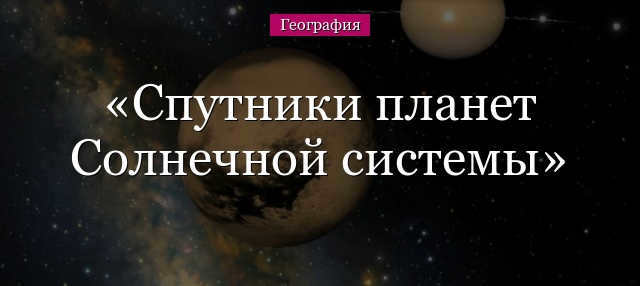
In our solar system, there are a total of eight planets, each with its own set of satellites. These satellites vary in terms of their origin, surface characteristics, and size. Unlike planets, satellites do not have their own axis of rotation and instead orbit their respective planets along a predetermined path. It’s worth noting that in the 20th century, humans also introduced artificial satellites into space alongside the natural ones.
General information
Planetary satellites are small celestial bodies that share a common characteristic – they revolve around the axis of the planet they accompany. Every satellite in the solar system lacks its own axis, meaning they always face their planet with the same side.
Venus and Mercury are the only two planets in the solar system without natural satellites. It is believed that Mercury had natural satellites in the past, but they disappeared over time. On the other hand, all other planets in the solar system have at least one natural satellite. Saturn holds the record for having the most discovered satellites – a total of 82.
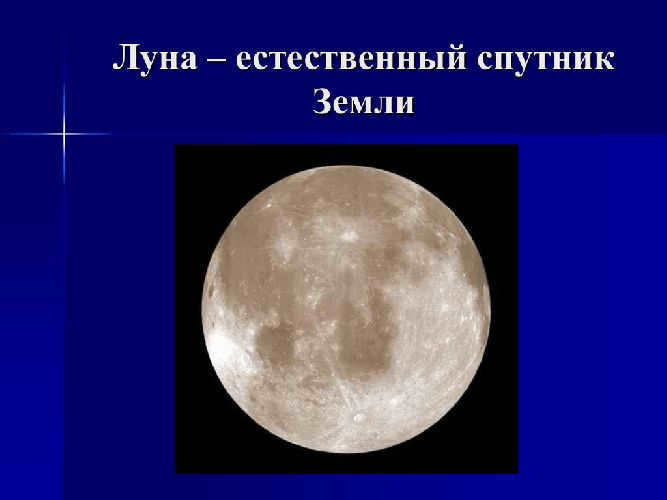
Satellite Classification
The solar system is home to numerous satellites, which can be classified into two main types based on their origin:
- Artificial satellites are spacecraft created by humans for various purposes such as weather observation, terrain monitoring, radio broadcasting, and military applications.
- Natural satellites are celestial bodies that occur naturally and orbit planets in a ring-like trajectory. Most natural satellites are believed to have formed from planetary debris or asteroids that gradually acquired a spherical shape. The Moon is a prime example of a natural satellite, sharing a similar chemical composition to that of Earth.
Contrary to popular belief, artificial satellites do not only orbit around Earth. In fact, there are over a dozen artificial satellites that orbit around the two closest planets to us, namely Venus and Mars. These satellites play a crucial role in enabling us to study and observe various aspects such as climatic conditions, changes in relief, and gather significant information about our planetary neighbors in space.
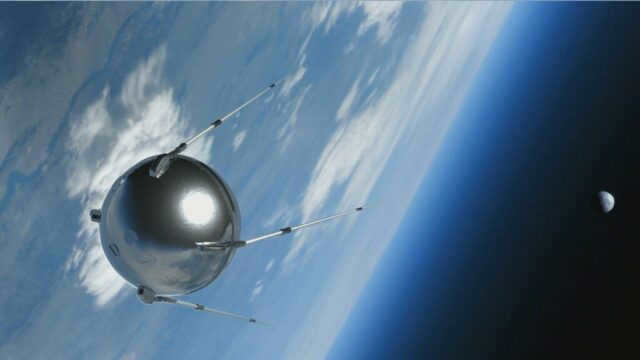
A convenient way to present the characteristics of the largest satellites of the planets is through a table.
Average density in grams per cubic centimeter
Second space velocity in meters per second
If we examine the list of satellite names, we will find that many of them are named after Greek mythological figures. For instance, Saturn’s satellites are named after titans, while Neptune’s satellites are named after mythological heroes associated with water.
Distinctive Characteristics of Natural Satellites
Natural satellites are primarily composed of a combination of rock and ice, distinguishing them from planets, which possess a metallic core and higher density.
Unlike planets, the majority of satellites lack an atmosphere, which serves as a natural shield against meteorites. Consequently, their surfaces exhibit a multitude of craters resulting from collisions with celestial bodies.
Some satellites boast unique surface features, such as the largest moons of Jupiter: Io and Europa. Io, for instance, is known for its active volcanoes, which eject molten sulfur hundreds of miles into space. Meanwhile, Europa resembles a frozen ice sphere with a potential subsurface ocean teeming with life.
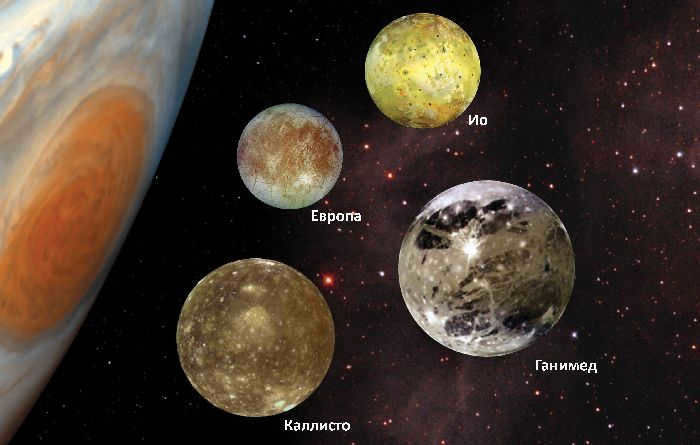
What have we discovered?
When composing a geography report for fifth graders, it is possible to define the concept of a satellite. A satellite is an object in space that orbits around a planet without rotating on its own axis. Additionally, we have identified the planets within our solar system that lack satellites – namely Mercury and Venus. Satellites can be either natural or artificial, with the latter being particularly valuable for gathering data about nearby planets.
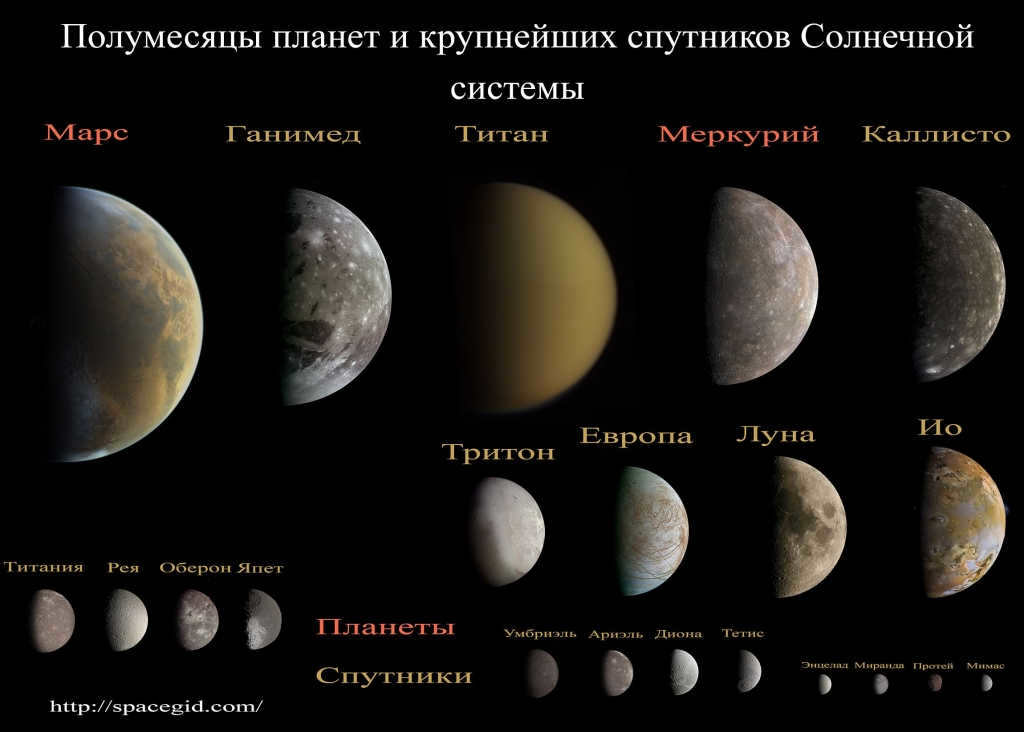
The presence of natural satellites is of immense significance for planets, and the impact of these space objects is felt by humans as well. This holds particularly true for Earth, which has a solitary natural satellite known as the Moon.
Basic details
Astronomers have been fascinated by the natural satellites of the planets in the solar system for centuries. Even today, scientists continue to explore these celestial objects. So, what exactly are these space entities?
The natural satellites of the planets are celestial bodies that occur naturally and orbit around the planets. As they are in close proximity to us, the natural satellites of the planets in the solar system hold a special interest for us.


In terms of size, let’s compare the largest satellites in the Solar System with the satellites of the planets in the Earth group.
Classification of satellites
There are two main types of satellites: natural satellites and artificial satellites. Natural satellites are objects that occur naturally and orbit around planets. On the other hand, artificial satellites are spacecrafts that are created by humans and are used to observe planets and other celestial bodies from space. These satellites serve various purposes such as weather observation, radio broadcasting, mapping the surface of the planet, and even military applications.
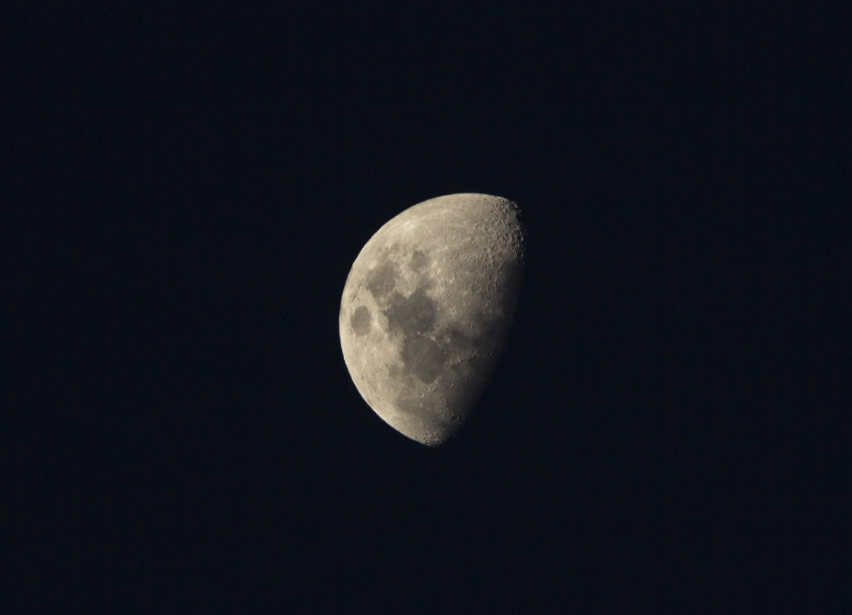
The International Space Station (ISS) holds the title for being the largest man-made satellite orbiting the Earth.
It’s important to recognize that Earth is not the only planet with artificial satellites, contrary to popular belief. In fact, there are over a dozen artificial satellites circling the two closest planets to us – Venus and Mars. These satellites enable us to study weather patterns, changes in the landscape, and gather other valuable information about our celestial neighbors.
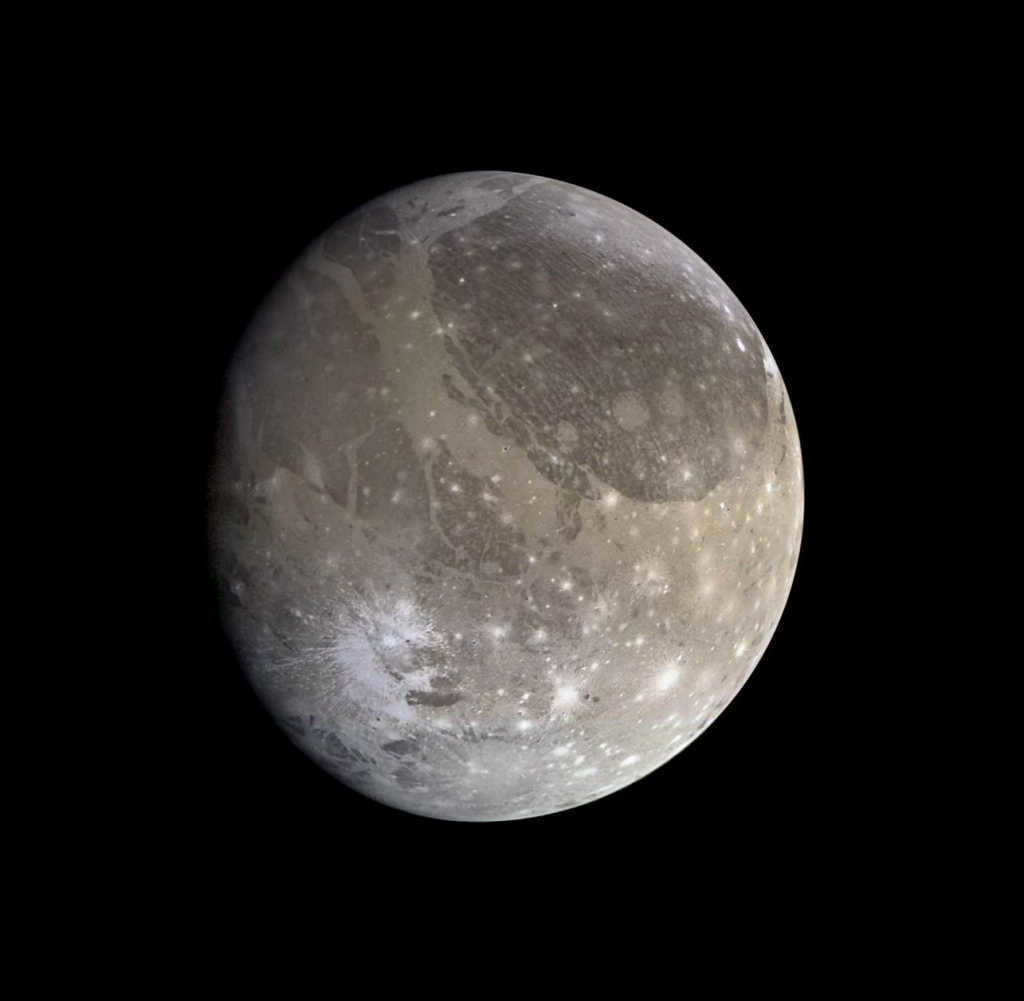

Ganymede holds the title for being the biggest moon in the Solar System.
The second group of satellites, known as natural satellites, is the focus of our discussion in this article. These natural satellites, unlike artificial satellites, were not created by humans, but rather formed by nature itself. It is believed that the majority of solar system satellites are actually asteroids that were captured by the gravitational pull of the planets. Over time, these asteroids transformed into spherical shapes and began orbiting their captor as permanent companions. Another theory suggests that these natural satellites are actually fragments of the planets themselves, which broke away during their formation. Interestingly, this theory applies to Earth’s natural satellite, the Moon. Chemical analysis of the Moon’s composition supports this theory, as it reveals a striking similarity to our own planet in terms of chemical compounds.
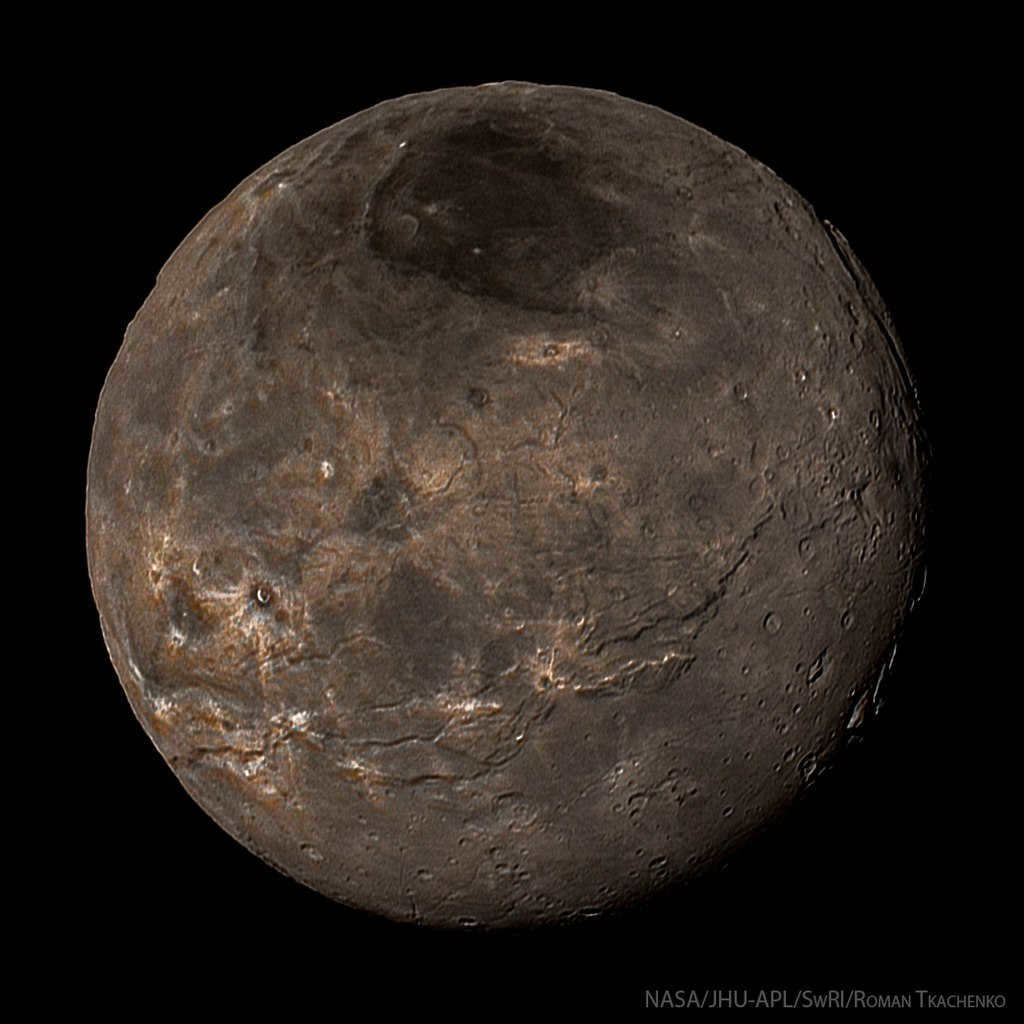
Charon, New Horizons photo
Charon, the natural satellite of Pluto, is one of the most captivating moons in the solar system. Its size is so substantial in comparison to Pluto that many astronomers refer to these celestial bodies as a binary dwarf planet. In fact, Pluto is only twice the size of its accompanying satellite.
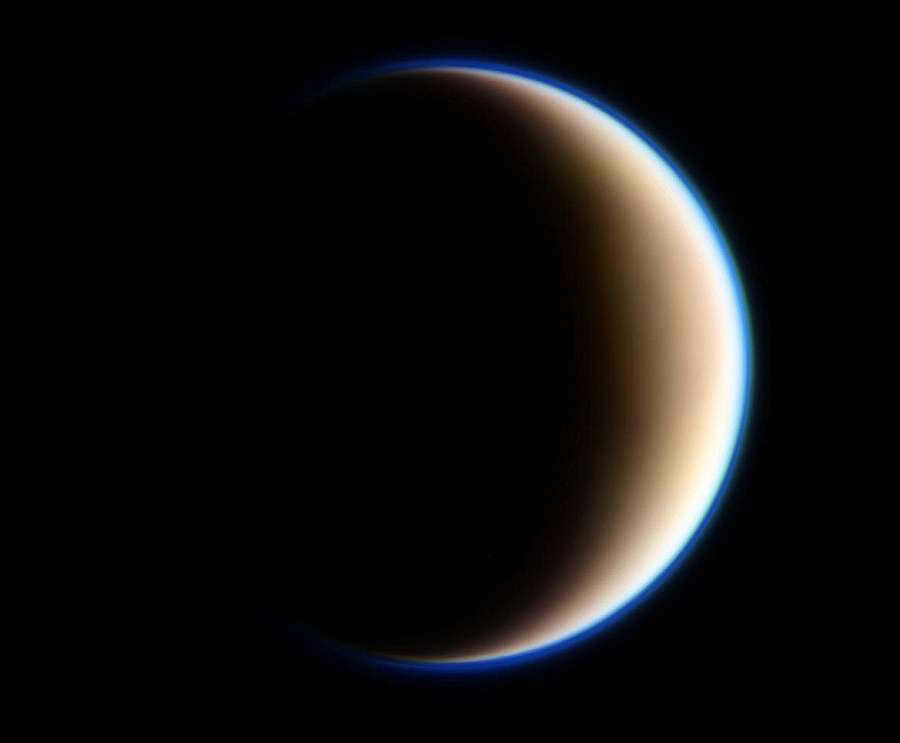
Astronomers are particularly intrigued by Titan, Saturn’s natural satellite. Unlike most natural satellites in our solar system, which are predominantly made up of ice, rock, or a combination of both, Titan boasts a dense atmosphere and even liquid hydrocarbon lakes.
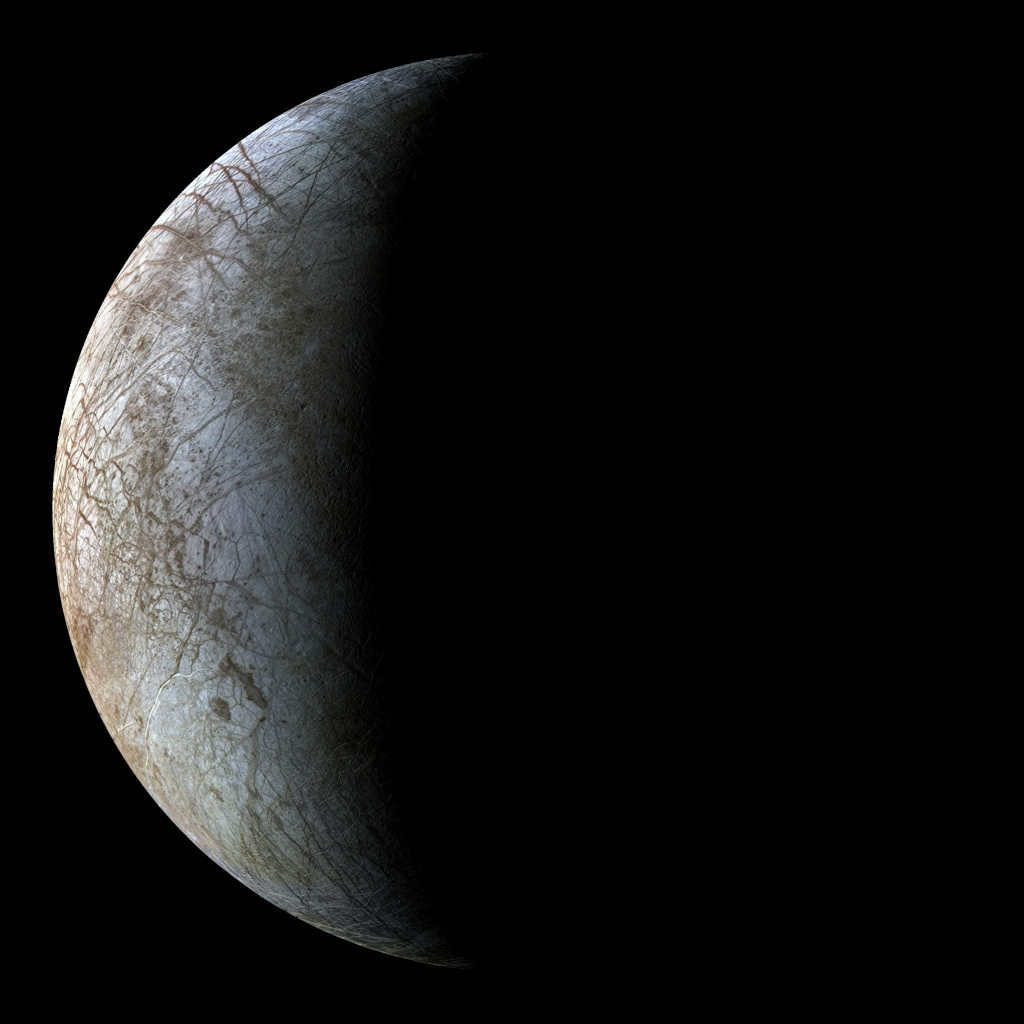
Europa, one of Jupiter’s natural satellites, holds promise for scientists in their search for extraterrestrial life. The satellite is believed to have an ocean beneath its icy surface, with thermal vents similar to those found on Earth. These vents support deep-sea life forms on our planet, leading to speculation that similar life forms could exist on Europa.
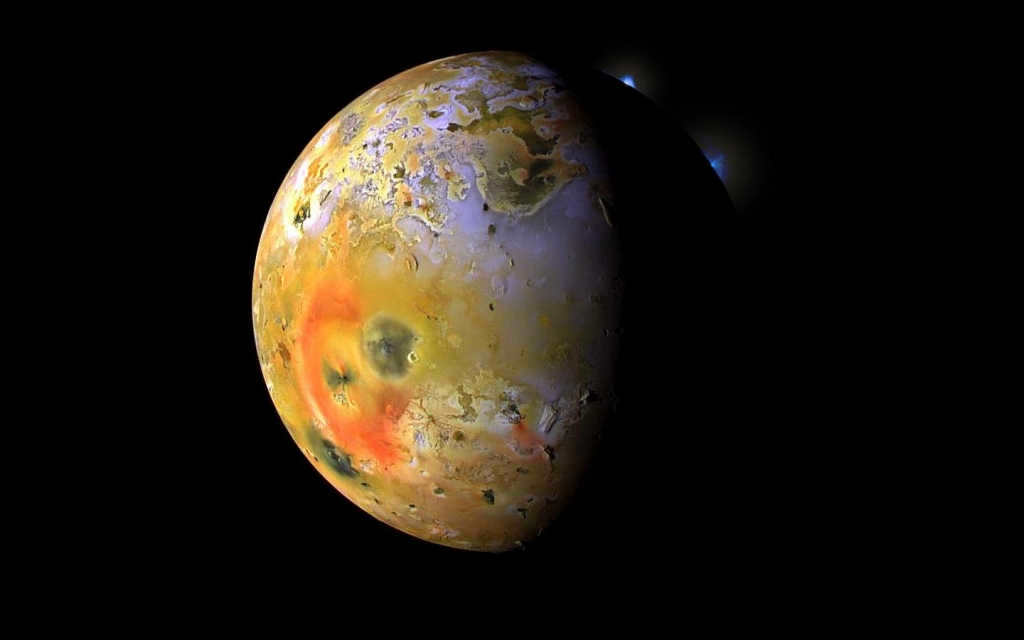
Jupiter, the largest planet in our solar system, is home to a unique and fascinating moon known as Io. Unlike any other moon in our system, Io is the only one where scientists have observed active volcanoes. This remarkable phenomenon has captured the attention of space explorers and astrophysicists alike.
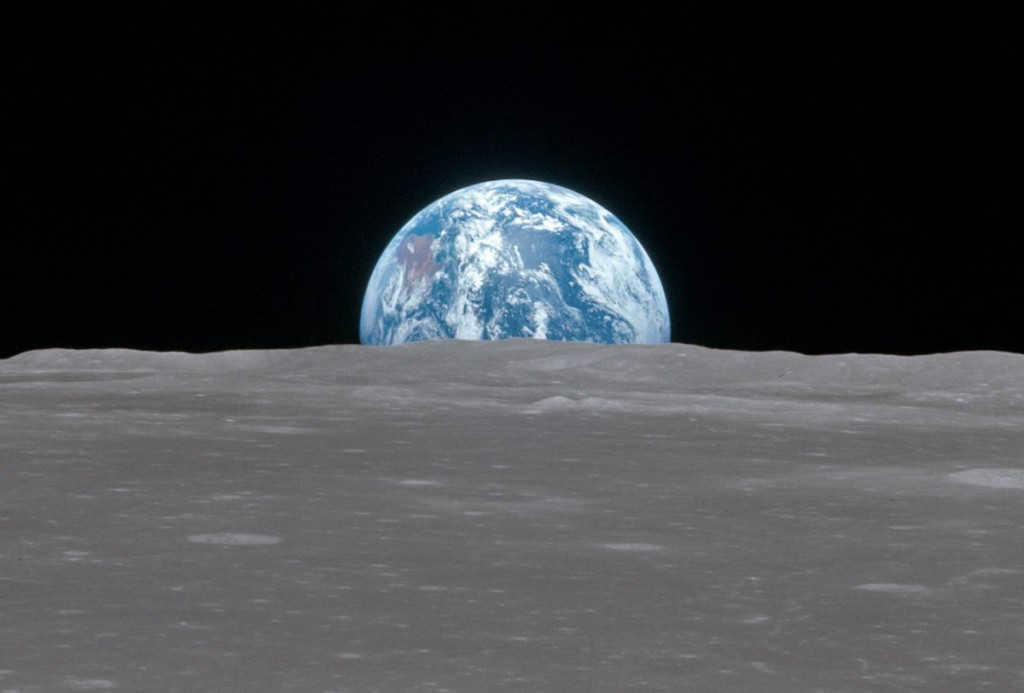
From the Moon’s orbit, the Apollo 11 astronauts captured an awe-inspiring image of the Earth on July 20, 1969.
For centuries, astronomers have been captivated by the natural satellites that orbit the planets of our solar system. Since the creation of the first telescope, scientists have been fervently studying these celestial bodies. With the advancement of civilization, we have not only discovered a vast number of satellites around various planets, but we have also been able to step foot on our own nearest and primary satellite—the Moon. On July 21, 1969, Neil Armstrong, an American astronaut, became the first human to set foot on the lunar surface alongside the crew of the Apollo 11 spacecraft. This historic achievement brought immense joy to humanity and remains one of the most significant events in the realm of space exploration.
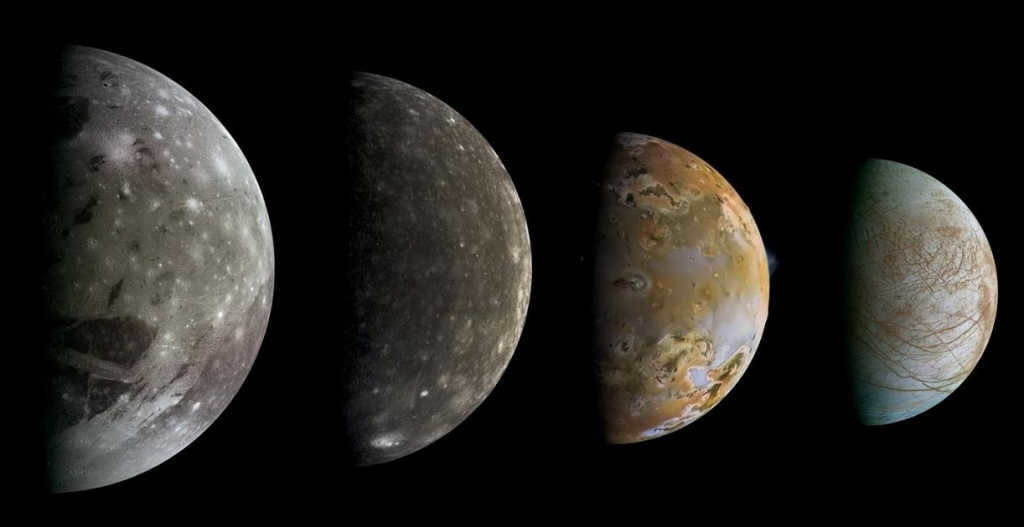
The natural satellites of the planets in our solar system, including Ganymede, Callisto, Io, and Europa, are being actively studied by scientists alongside the Moon. Astronomers utilize various methods such as visual and radar observations, as well as modern spacecraft and artificial satellites to gather information. A notable example is the Voyager spacecraft, which provided the first-ever images of Jupiter’s largest satellites: Callisto, Io, Ganymede, and Europa. Thanks to these groundbreaking images, scientists were able to confirm the existence of volcanoes on Io and an ocean on Europa.
At present, the international community of space scientists remains deeply involved in the exploration of the natural satellites orbiting the planets within our solar system. Alongside numerous government initiatives, private enterprises have also emerged with the goal of investigating these celestial bodies. One prominent example is the renowned American corporation known as “Google,” which is presently spearheading the development of a lunar rover designed for tourism purposes. This groundbreaking vehicle would provide the opportunity for countless individuals to experience a leisurely stroll on the Moon.
As of 2017, there are a total of 175 satellites orbiting around the planets in our solar system, excluding Mercury and Venus. In this lesson, we will explore the largest satellites of these planets and delve into their unique characteristics, including their structure and relief.
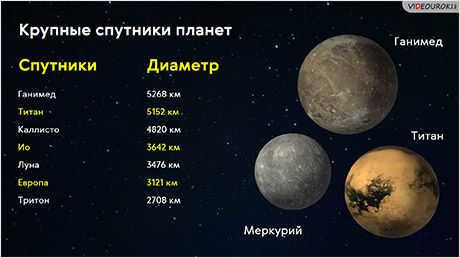
Currently, it is not possible to view or share the video lesson with students
In order to access this and other video lessons included in the kit, you will need to add it to your personal account.
Unlock amazing possibilities


Prospectus of the lesson “Moons of the planets”
It is a well-known fact that satellites orbit around the giant planets, with the exception of Mercury and Venus. As of 2017, there were 175 known satellites in total. Interestingly, the Earth-group planets have only three satellites: the Moon for Earth, and Phobos and Deimos for Mars.
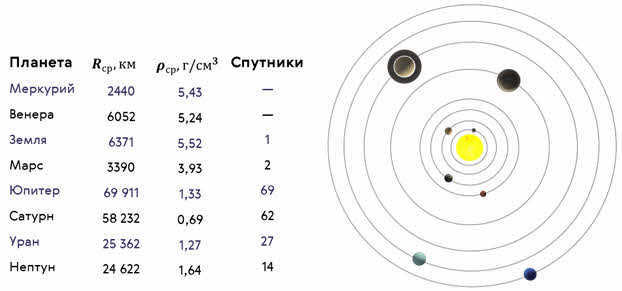
The majority of the planets’ satellites are relatively small, measuring just a few tens of kilometers in diameter. These satellites are composed of a combination of stone and ice, and have an irregular shape. For instance, Saturn’s moon Pan resembles a massive dumpling, with a diameter of approximately 35 kilometers. These satellites have surfaces that are marked by numerous small craters and covered in a layer of dust.
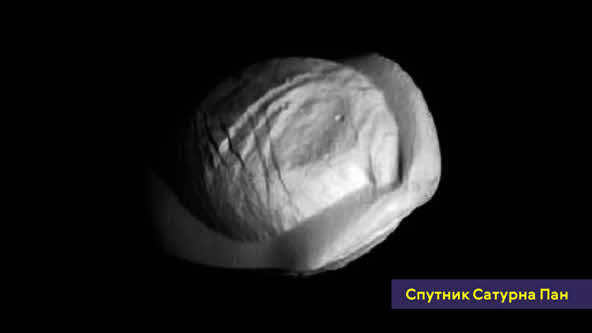
Medium-sized satellites are typically spherical objects with a diameter of a few hundred kilometers. In appearance, their surface bears a resemblance to that of the Moon.
There are seven satellites, including our Moon, that have a diameter exceeding 2500 kilometers. Ganymede and Titan, for instance, are even larger than Mercury. The surfaces of these satellites display a variety of features, and their structure more closely resembles that of the Earth’s group of planets.
The four largest satellites of Jupiter – Ganymede, Callisto, Io, and Europa – were first observed by the renowned Italian scientist Galileo Galilei in 1610. Therefore, they are also referred to as Galileo’s satellites. The closest one to Jupiter is Io, which is named after the mythological lover of Zeus. With an average radius of 1821.3 kilometers, it is the fourth-largest satellite in the entire solar system.
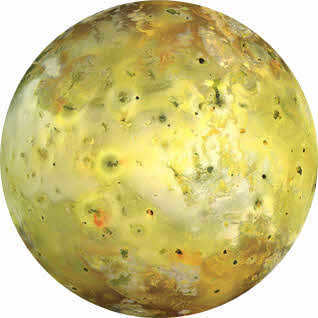
Furthermore, Io is the most geologically active celestial body in the entire solar system. Over 400 active volcanoes have been discovered on its surface. During intense eruptions, these volcanoes erupt sulfur and sulfur dioxide, reaching heights of up to 500 kilometers.
The volcanic activity on Io creates distinctive features and colors on its surface. Ashes and lava flows, which can extend up to 500 kilometers, give the surface various hues of red, yellow, white, black, and green.
In addition, the satellite is home to approximately 150 mountains, formed by compression within its silicate crust. Some of these mountains exceed the height of Mount Everest on Earth. For instance, Mount South Boosavla boasts a relative elevation of 18.2 kilometers.
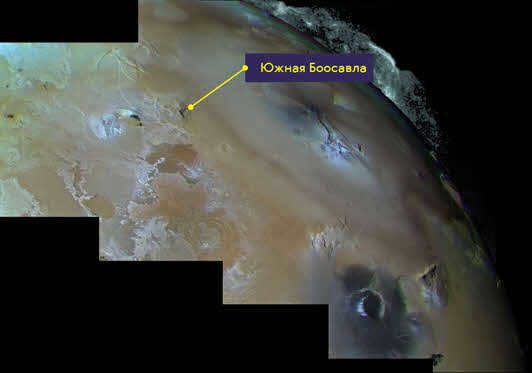
Io, composed primarily of silicate rocks and iron, has a composition more similar to the planets in the Earth group rather than the satellites located in the outer regions of the solar system. Additionally, Io’s average density (3.53 g/cm 3 ) is even higher than that of the Moon.
One theory about the internal structure of Io proposes the existence of a central core, the size of which depends on its composition. This core is surrounded by a partially molten mantle and a crust that is at least 12 kilometers thick. Io’s atmosphere is extremely thin and primarily consists of 90% sulfur dioxide.
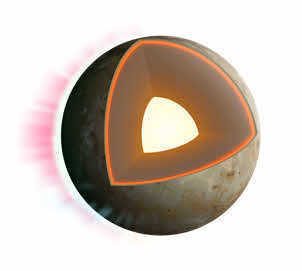
The second satellite of Jupiter that is farthest from the planet is Europa. It received its name in tribute to the daughter of the Phoenician ruler, who was a beloved of Zeus. Europa has an average radius of 1560.8 kilometers and a density of 3.014 g/cm3.
Europa revolves around Jupiter in an orbit that is nearly circular, with a radius of 671,100 kilometers. Similar to all the other Galilean satellites, Europa always presents the same side to Jupiter.
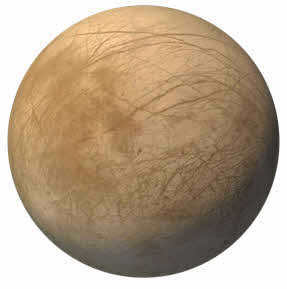
Europa, the second-largest moon in the solar system, holds the impressive position of being the sixth largest satellite in terms of size. What makes Europa even more fascinating is that despite its size, it has a greater mass than all the smaller satellites combined. This intriguing characteristic has led scientists to propose that at the core of Europa lies an iron center encased by silicate rocks.
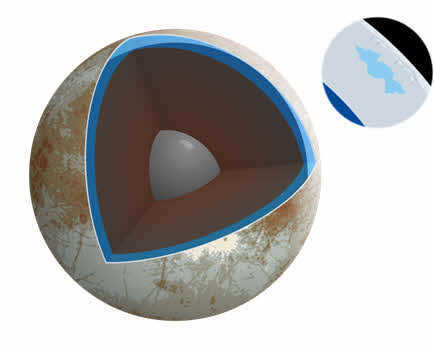
Europa, a moon of Jupiter, is completely covered in ice and boasts one of the most uniform surfaces in our solar system. Unlike other celestial bodies, Europa has very few impact craters, but is instead marked by numerous cracks. The topography of certain areas suggests that the ice was once melted, allowing ice floes and icebergs to float in the water. The frozen remnants of these ice floes can still be observed on the surface, revealing that they were once connected before separating.
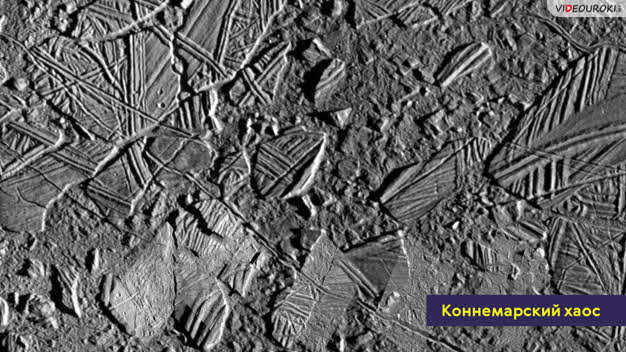
The Puyl impact crater on Europa is an intriguing feature, with its central mountain rising above the surrounding rampart. It is believed that viscous ice or water flowed out of the asteroid’s crater and onto the surface of Europa.
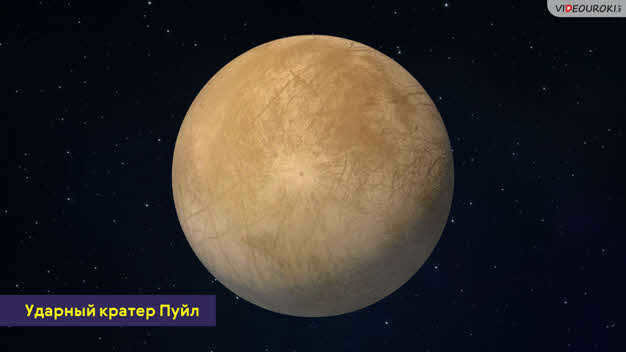
Moreover, indications of water vapor discharge were detected in the vicinity of the southern pole of Europa, which is a result of geysers erupting from cracks in the icy surface. This discovery has provided scientists with sufficient evidence to support the existence of a subterranean water ocean beneath the thick layer of ice on this moon. Some experts even speculate that its depth may extend up to 100 kilometers, with a volume twice as large as that of Earth’s oceans (3 ∙ 10 18 m 3 ).
Due to the intriguing characteristics of Europa, as well as the potential for extraterrestrial life, NASA decided to allocate funds from its budget in 2016 to develop an interplanetary mission dedicated to an in-depth exploration of this Jupiter moon. The launch of the spacecraft is planned for the mid-2020s.
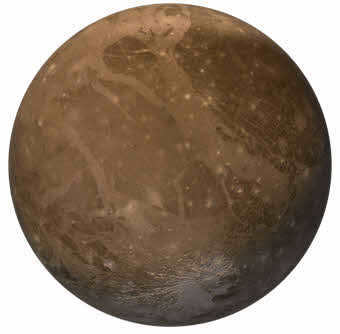
The average size of the satellite is 2634.1 kilometers, which is approximately 8% larger than that of Mercury. The average density of Ganymede is 1.936 g/cm 3 , and it has a mass that is 2.5% of the Earth’s mass and only 45% of Mercury’s mass.
Ganymede is believed to be made up of three layers: a liquid iron core and equal amounts of silicate rock and ice.
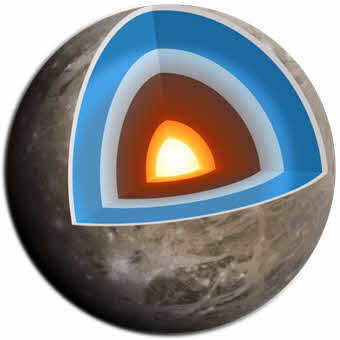
It is also believed that there may be an ocean of salty liquid water beneath the thick outer layer of ice, approximately 200 kilometers deep. The presence of two distinct types of landscape on the surface of Ganymede further supports this theory. Roughly one third of the surface is covered in dark areas with numerous impact craters, estimated to be around 4 billion years old. The remaining surface is lighter in color and younger, characterized by grooves and ridges.
One notable feature on Ganymede is the Galileo region, a dark area with a network of varied grooves. It has a rounded shape and well-defined boundaries.
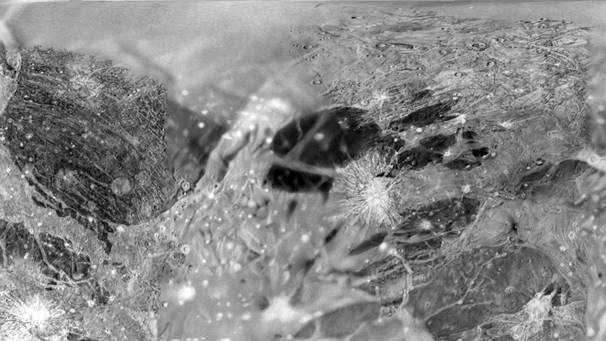
Callisto, the final moon among Jupiter’s four Galilean satellites, bears the name of another one of Zeus’ lovers. It holds the distinction of being the second largest moon orbiting Jupiter and the third largest in the entire solar system. With a radius of 2410.3 kilometers, Callisto measures approximately 0.378 times the radius of Earth.
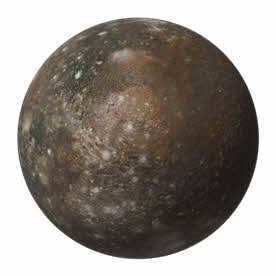
Callisto, with a mass of approximately 1 ∙ 10 23 kilograms, has an average density of slightly over 1.83 g/cm 3 . As a result, it is believed that the surface layer is supported by an icy lithosphere that can be as thick as 150 kilometers, according to a model of its internal structure.
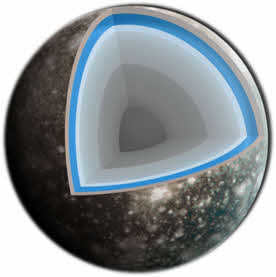
Below the icy crust lies a potentially vast ocean of saltwater, estimated to be 50-200 kilometers deep. Below the ocean, there is a mixture of substances that gradually increase in silicate content with depth. If there is a core, it is believed to be very small, with a radius not exceeding 600 kilometers.
One of the notable features on Callisto’s surface are the multi-ringed basins, known as cirques. The largest of these is called Valhalla (refer to the figure). At the center of Valhalla is a bright region with a diameter of approximately 600 kilometers, surrounded by concentric rings that extend up to 1800 kilometers in radius.
Now, let’s shift our focus to Saturn. This planet is home to the second largest satellite in the solar system, known as Titan.
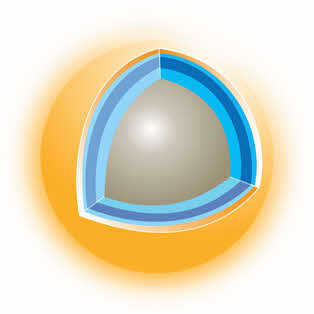
Titan has an average radius of approximately 2,576 kilometers, making it 50% larger than the Moon and 5% larger than Mercury. Its average density is about 1.88 g/cm3, similar to Mercury and Ganymede. Unlike any other satellite, Titan possesses a 400-kilometer-thick atmosphere, with over 98.4% composed of nitrogen. The remaining constituents consist of argon and methane. The temperature on Titan’s surface typically hovers around -180 degrees Celsius, causing methane to condense and precipitate as rain.
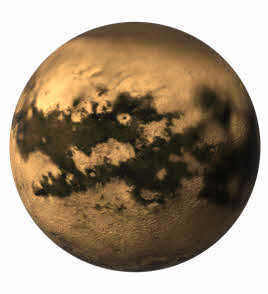
The satellite’s radar images clearly show mountain ranges, methane rivers, and dark spots that were initially believed to be either filled or dried up methane lakes. However, in July 2009, the Cassini spacecraft detected a reflection from the smooth surface of a liquid pool in the infrared. This discovery provides undeniable evidence of the presence of liquid on Titan. Enormous lakes were found near the satellite’s north pole. The largest among them is called the Kraken Sea, stretching over 1000 kilometers and comparable in size to the Caspian Sea. Another significant lake, the Sea of Ligeia, has a larger area (about 100,000 km2) than any freshwater lake on Earth.
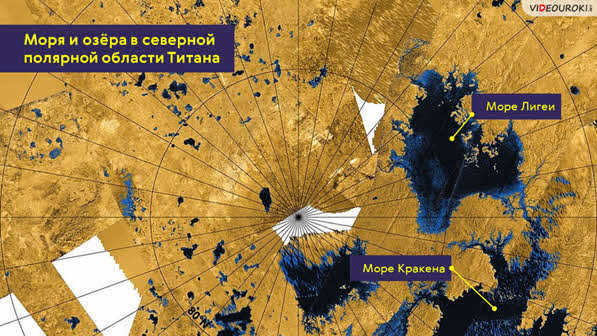
Titan has recently become the most distant object in the solar system to have a research vehicle land on its surface. The probe named “Huygens” successfully landed on Titan and captured images of its complex surface topography, which showed evidence of liquid activity. Additionally, the probe recorded the sound of wind on Titan using an external microphone and transmitted it back to Earth.
Our next destination takes us to the vicinity of Neptune. Here, we find Triton, the seventh largest satellite in the solar system. Triton was discovered just 17 days after the planet itself was discovered.
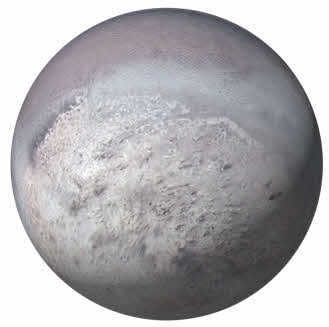
Having a diameter of approximately 2,706 kilometers, Triton is larger than both Pluto and Erida, the largest dwarf planets. The satellite possesses a density of 2.061 g/cm) and a mass of 2.14 ∙ 10 22 kg.
Scientists hypothesize that Triton harbors a rock-metal core within its interior, comprising around two-thirds (2/3) of the satellite’s total mass. Surrounding the core is an icy mantle, layered with a crust of water ice and a surface layer of nitrogen ice.
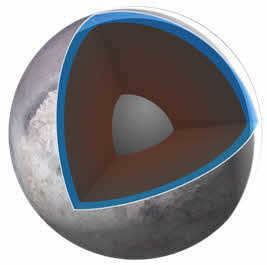
During the Voyager 2 flyby, the satellite recorded only 179 impact craters (in comparison, Miranda, a moon of Uranus, has 835 craters, despite its surface area being only about 3% of Triton’s). This small number of craters suggests that the surface is relatively young, with an age of no more than a hundred million years. Triton is one of the few moons in the solar system that is geologically active. Evidence of tectonic activity, complex topography, and cryovolcanoes that spew nitrogen gas all point to its intricate geological history.
In common usage, a natural satellite is an astronomical body that orbits a planet, dwarf planet, or small body in the solar system (or sometimes another natural satellite).
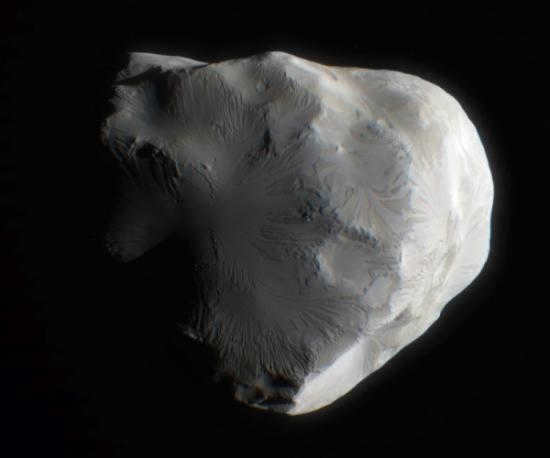
Within our solar system, there exist six distinct satellite systems orbiting various planets, comprising a total of 226 confirmed natural satellites. Additionally, astronomers have identified seven dwarf planets that also possess natural satellites: Orcus, Pluto, Haumea, Kwawar, Makemake, Gongong, and Erida. As of November 2021, our knowledge extends to a total of 442 minor planets accompanied by their own natural satellites.
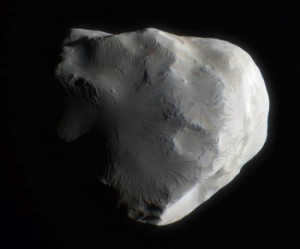
The solar system’s planets generally have masses that are at least 10,000 times greater than those of their natural satellites, resulting in significantly larger diameters.
The Earth-Moon system is a rare exception in the solar system. The Moon, with a diameter of 3474 km (2158 miles), is only 0.273 times the diameter of Earth and has approximately 1/80th of its mass.
The highest ratios after the Earth-Moon system are found in the Neptune-Triton system, with a ratio of 0.055 (and a mass ratio of approximately 1 in 5000), the Saturn-Titan system with a ratio of 0.044 (the second highest mass ratio after the Earth-Moon system, approximately 1 in 4250), the Jupiter-Ganymede system with a ratio of 0.038, and the Uranus-Titania system with a ratio of 0.031. Among dwarf planets, Charon has the largest ratio: a diameter 0.52 times that of Pluto and 12.2% of its mass.
Astronomers are perplexed by the variety in size and origin of satellites. There are two that surpass the planet Mercury in size, and eight that exceed Pluto. The Moon, our closest celestial companion, ranks as the fifth largest natural satellite among the planets in our solar system, measuring 3474 kilometers in diameter.
The appearance of satellites in the planets of the solar system
The majority of satellites are believed to have originated from a disk of debris during the formation of the planet they orbit. Nonetheless, Triton, the largest satellite of Neptune, and a few of the smallest satellites (including the Martian satellites) might have formed in different regions of the solar system. Our Moon most likely took shape from fragments of a Mars-sized object that crashed into the early Earth, making it probably the most exceptional instance in the solar system’s chronicles.
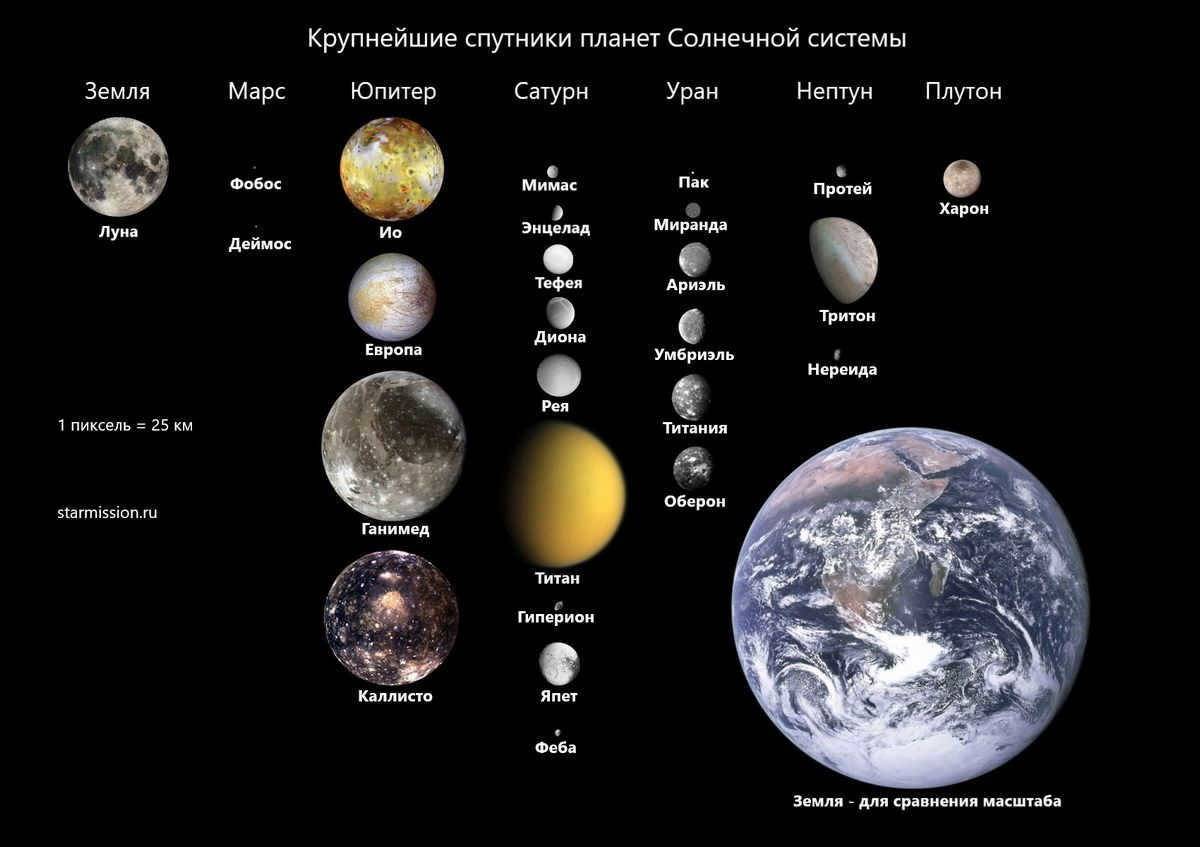
Moons of the Planets
The Earth is orbited by the Moon.
Mars has two moons called Phobos and Deimos.
Jupiter has a total of about 63 satellites, including Io, Europa, Ganymede, and Callisto (as of 2005).
Saturn has 62 satellites, including Mimas, Enceladus, Tefia, Dione, Rhea, Titan, Helen, and Japhet. It also has hundreds of large fragments in its rings.
Uranus has a total of 27 satellites, including Miranda, Ariel, Umbriel, Titania, and Oberon.
Neptune has 13 satellites, including Triton, Proteus, Nereid, Naiad, Thalassa, Despina, Larissa, and Galatea.





